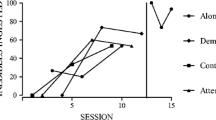Abstract
Overcorrection and physical restraint procedures have been shown to be effective in controlling certain classes of maladaptive behavior in mentally retarded persons. In the present study, an alternating treatments design was used to measure the differential effects of overcorrection and physical restraint procedures in the treatment of pica. Changes in collateral behaviors were also monitored. Each occurrence of pica was followed by either an overcorrection procedure or a physical restraint procedure. Although both procedures reduced the occurrence of pica and had a similar effect on the occurrence of collateral behaviors, physical restraint was clinically more effective in terms of immediate response reduction.
Similar content being viewed by others
References
Ausman, J., Ball, T. S., & Alexander, D. (1974). Behavior therapy of pica in a profoundly retarded adolescent.Mental Retardation, 12, 16–18.
Baltrop, D. (1966). The prevalence of pica.American Journal of Diseases of Children, 112, 116–123.
Barlow, D. H., & Hayes, S. C. (1979). Alternating treatments design: One strategy for comparing the effects of two treatments in a single subject.Journal of Applied Behavior Analysis, 12, 199–210.
Bucher, B., Reykdal, B., & Albin, J. (1976). Brief restraint to control pica in retarded children.Journal of Behavior Therapy and Experimental Psychiatry, 7, 137–140.
Danford, E. E., & Huber, A. M. (1982). Pica among mentally retarded adults.American Journal of Mental Deficiency, 87, 141–146.
Foxx, R. M., & Martin, E. D. (1975). Treatment of scavenging behavior (coprophagy and pica) by overcorrection.Behaviour Research and Therapy, 13, 153–162.
Grossman, H. D. (1977).Manual on terminology and classification in mental retardation. Washington, D.C.: American Association on Mental Deficiency.
Kanner, C. (1962).Child psychiatry. Springfield, Illinois: Charles C Thomas.
Lourie, R. S., & Millican, F. K. (1969). Pica. In J. G. Howells (Ed.),Modern perspectives in international psychiatry (pp. 455–470). Edinburgh: Oliver & Boyd.
Madden, N. A., Russo, D. C., & Cataldo, M. F. (1980). Behavioral treatment of pica in children with lead poisoning.Child Behavior Therapy, 2(4), 67–81.
Matson, J. L., Stephens, R. L., & Smith, C. (1978). Treatment of self-injurious behavior with overcorrection.Journal of Mental Deficiency Research, 22, 175–178.
Mulick, J. A., Barbour, R., Schroeder, S. R., & Rojahn, J. (1980). Overcorrection of pica in two profoundly retarded adults: Analysis of setting effects, stimulus and response generalization.Applied Research in Mental Retardation, 1, 241–252.
Ollendick, T. H., Shapiro, E. S., & Barrett, R. P. (1981). Reducing stereotypic behaviors: An analysis of treatment procedures utilizing an alternating treatments design.Behavior Therapy, 12, 570–577.
Shapiro, E. S., Barrett, R. P., & Ollendick, T. H. (1980). A comparison of physical restraint and positive practice overcorrection in treating stereotypic behavior.Behavior Therapy, 11, 227–233.
Singh, N. N., & Winton, A. S. W. (1982).Pica in institutionalized mentally retarded persons. Unpublished data, University of Canterbury.
Singh, N. N., & Winton, A. S. W. (1984). Effects of a screening procedure on pica and collateral behaviors.Journal of Behavior Therapy and Experimental Psychiatry, 15, 59–65.
Snowdon, C. T. (1977). A nutritional basis for lead pica.Physiology and Behavior, 18, 885–893.
Winton, A. S. W., & Singh, N. N. (1983). Suppression of pica using brief-duration physical restraint.Journal of Mental Deficiency Research, 27, 93–103.A1260007 00009 CS-SPJRNPDF [HEADSUP]
Author information
Authors and Affiliations
Additional information
The experimental protocol for this study was reviewed and approved by the Ethics Committee of the North Canterbury Hospital Board. This research was supported in part by Grants No. 10 and No. 82-59 from the New Zealand Labor Department. The authors are grateful to Dr. Jim Marshall, Peter Bootsma, and the ward staff of Templeton Hospital and Training School for their generous assistance. A special thanks to Lyonne Dalley, Jane Guillen, and Robin Phillips, who assisted with the manuscript preparation.
Rights and permissions
About this article
Cite this article
Singh, N.N., Bakker, L.W. Suppression of pica by overcorrection and physical restraint: A comparative analysis. J Autism Dev Disord 14, 331–341 (1984). https://doi.org/10.1007/BF02409583
Issue Date:
DOI: https://doi.org/10.1007/BF02409583




